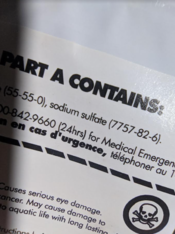Hello,
I want to prepare a home-mixed Microphen as follows:
Package A
Sodium metabisulfite 0.65 g
Hydroquinone 5.00 g
Boric acid 2.80 g
Phenidone 0.20 g
Package B
Sodium tripolyphosphate (or Calgon) 3.40 g
Sodium sulfite (anh.) 100.00 g
Borax 6.80 g
Potassium bromide 1.00 g
!!! Sodium sulfate ?? g !!!
In the original Ilford Microphen I saw that in Package B they add Sodium sulfate. The amount is unknown, but maybe somewhere around 10-12 grams. Does anyone have any idea what they are using it for?
My first guess was that it was like an anti-caking agent. I looked at the ingredients of the other two Ilford powder developers (Perceptol and ID-11) - in the first they did not write it, but in the second surprisingly there is sulfate, but in package A, where the two developing agents are...
I want to prepare a home-mixed Microphen as follows:
Package A
Sodium metabisulfite 0.65 g
Hydroquinone 5.00 g
Boric acid 2.80 g
Phenidone 0.20 g
Package B
Sodium tripolyphosphate (or Calgon) 3.40 g
Sodium sulfite (anh.) 100.00 g
Borax 6.80 g
Potassium bromide 1.00 g
!!! Sodium sulfate ?? g !!!
In the original Ilford Microphen I saw that in Package B they add Sodium sulfate. The amount is unknown, but maybe somewhere around 10-12 grams. Does anyone have any idea what they are using it for?
My first guess was that it was like an anti-caking agent. I looked at the ingredients of the other two Ilford powder developers (Perceptol and ID-11) - in the first they did not write it, but in the second surprisingly there is sulfate, but in package A, where the two developing agents are...













